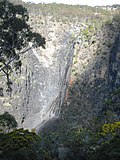Oxley Wild Rivers National Park
Oxley Wild Rivers National Park is a national park in the state of New South Wales, Australia. It is roughly halfway between Sydney and Brisbane, around 80 km from Dorrigo. Its name comes from the explorer John Oxley, who also crossed this area.
The national park was placed under protection in September 1986. It covers an area of approximately 142,332 hectares.[1] These are several, non-contiguous sub-areas.
The Oxley Wild Rivers National Park borders the Willi Willi National Park.
Nature
The national park has an impressive landscape in many areas with deep gorges and high waterfalls. Well known is the Wollomombi Falls, the highest waterfall in New South Wales.
The predominant plant communities are rainforests, dry eucalyptus forests, grassy woodlands and heathland.[2] A total of about 950 plant species have been documented in the park, of which about 35 are considered rare and endangered.[2]
In addition, 55 mammals, 173 bird, 38 reptile and 19 amphibian species have been recorded in the national park.[2]
In addition to the populations of the grey giant kangaroos, the wallaroos or mountain kangaroos and the red-necked filanders, the occurrence of the brush-tailed rock kangaroos, of which around 10,000 are found in the national park, are particularly noteworthy. This is the largest known population anywhere. You can also do this in the park Watch koalas and wombats.
Among the bird species are particularly the birds of prey, including the wedge-tailed eagle on its prey flights, the peregrine falcon, crested kite (Lophoictinia isura) and the white-bellied sea eagle.
Introduced animals such as mice and rats as well as feral domestic animals such as horses, goats, cats and dogs can disturb the ecological balance in the park and may be combated by the national park administration.
Tourism
There are various accommodations, campsites and hiking trails for tourists, some of which are even usable for wheelchair users and open up various viewing platforms.[3]
Further protection categories
In 1987 the national park became a UNESCO World Heritage Site as part of Australia's Gondwana Rainforests.[4]
Oxley Wild Rivers National Park Media
Dangars Gorge, near Armidale
Stinging tree (Dendrocnide excelsa)
Paradise Rocks and Apsley River from The Terrace, Riverside
Dangars Falls, near Armidale
References
- ↑ "Park management". NSW Environment, Energy and Science. Retrieved 2021-09-23.
- ↑ 2.0 2.1 2.2 "Oxley Wild Rivers National Park". NSW National Parks. Retrieved 2021-09-23.
- ↑ Information on leisure activities (NSW Parks and Wildlife Services)
- ↑ "New England National Park". NSW National Parks. Retrieved 2021-09-23.
Other websites
![]()









